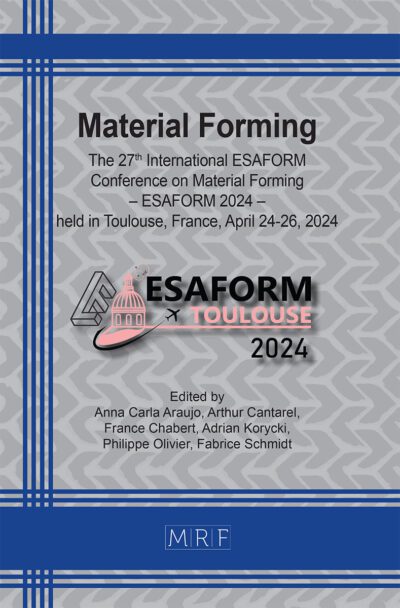Heat-assisted forming of high strength low alloy S700MC steel
Mehmet Okan Görtan, Melih Tuyan, Ali Osman Gündoğdu
Abstract. One of the most significant trends that has shaped the automotive industry over the last 20 years is weight reduction. The most commonly used strategy to achieve this is replacing the materials with stronger ones. In this way, it becomes possible to reduce vehicle weight by carrying the same loads with smaller cross-sections, without compromising passenger safety. In the current study, heat-assisted forming characteristics of high strength low alloy S700MC steel has been investigated and validated using a sheet metal suspension control arm. It has been found that the ductility of the S700MC steel can be increased significantly at temperatures below blue brittleness region. Moreover, hardness levels of the samples formed at elevated temperatures was higher than the as-received ones.
Keywords
High Strength Steel, Mild Temperature Forming, Stamping
Published online 5/7/2025, 9 pages
Copyright © 2025 by the author(s)
Published under license by Materials Research Forum LLC., Millersville PA, USA
Citation: Mehmet Okan Görtan, Melih Tuyan, Ali Osman Gündoğdu, Heat-assisted forming of high strength low alloy S700MC steel, Materials Research Proceedings, Vol. 54, pp 1027-1035, 2025
DOI: https://doi.org/10.21741/9781644903599-111
The article was published as article 111 of the book Material Forming
![]() Content from this work may be used under the terms of the Creative Commons Attribution 3.0 license. Any further distribution of this work must maintain attribution to the author(s) and the title of the work, journal citation and DOI.
Content from this work may be used under the terms of the Creative Commons Attribution 3.0 license. Any further distribution of this work must maintain attribution to the author(s) and the title of the work, journal citation and DOI.
References
[1] S. Keeler, M. Kimchi, P.J. Mooney (Eds.), Advanced High-Strength Steels Application Guidelines Version 6.0, 2017.
[2] T. Trzepieci´nski, and S.M. Najm. Current Trends in Metallic Materials for Body Panels and Structural Members Used in the Automotive Industry. Materials. 17 (2024) 590. https://doi.org/10.3390/ma17030590
[3] R. Pereira, N. Peixinho, S.L. Costa. A Review of Sheet Metal Forming Evaluation of Advanced High-Strength Steels (AHSS). Metals. 14 (2024), 394. https://doi.org/10.3390/met14040394
[4] M. Tisza, I. Czinege. Comparative Study of the Application of Steels and Aluminium in Lightweight Production of Automotive Parts. Int. J. Lightweight Mater. Manuf. 1 (2018) 229–238. https://doi.org/10.1007/s12206-016-0140-7
[5] J.R. Fekete. Manufacturing Challenges in Stamping and Fabrication of Components from Advanced High Strength Steel. In Proceedings of the International Symposium on Niobium Microalloyed Sheet Steel for Automotive Applications, Araxa, Brazil, 5–8 December (2005); pp. 107–115.
[6] E.-M. Lee, D.-S. Shim, J.-Y. Son, G.-Y. Baek, H.-S. Yoon, K.-B. Ro. Study on Design of Progressive Dies for Manufacture of Automobile Structural Member Using DP980 Advanced High Strength Steel. J. Mech. Sci. Technol. 30 (2016) 853–864. https://doi.org/10.1007/s12206-016-0140-7
[7] H. Karbasian, A.E. Tekkaya, A review on hot stamping, J. Mater. Process. Technol. 210 (2010) 2103-2118. https://doi.org/10.1016/j.jmatprotec.2010.07.019
[8] I. Wróbel, A. Skowronek, A. Grajcar. A Review on Hot Stamping of Advanced High-Strength Steels: Technological-Metallurgical Aspects and Numerical Simulation. Symmetry 14 (2022) 969. https://doi.org/10.3390/sym14050969
[9] Z. Hou, Y. Liu, Q. He. Low-Carbon-Emission Hot Stamping: A Review from the Perspectives of Steel Grade, Heating Process, and Part Design. Automot. Innov. 6, (2023) 324–339. https://doi.org/10.1007/s42154-023-00242-3
[10] M. Merklein, M. Wieland, M. Lechner, S. Bruschi, A. Ghiotti. Hot stamping of boron steel sheets with tailored properties: A review. J. Mater. Process. Technol. 228 (2016) 11-24. https://doi.org/10.1016/j.jmatprotec.2015.09.023
[11] E. Meza-Garcia, A. Rautenstrauch, M. Braunig, V. Krausel, D. Landgrebe, Energetic evaluation of press hardening processes, Proc. Manuf. 33 (2019) 367-374. https://doi.org/10.1016/j.promfg.2019.04.045
[12] V.M. Matyunin, V.N. Varavka, O.V. Kudryakov. Assessment of the Blue Brittleness Range of Steel. Russ. Metall. (2023) 2101–2106. https://doi.org/10.1134/S0036029523700155
[13] M.C. Sun, W. Xue. The blue brittleness of 1Cr17Ni2 steel submarine motor shaft, Mater. Lett. 57 (2002) 369-373. https://doi.org/10.1016/S0167-577X(02)00794-2
[14] K. Nakazima, T. Kikuma, K. Hasaku. Study on the formability of steel sheet. Yawata Technol. Rep. 1968, 264, 8517–8530
[15] Z. Marciniak, K. Kuczynski. Limit strains in the processes of stretch forming sheet metal. Int. J. Mech. Sci. 9 (1967) 609–612
[16] W.-J. Chen, H.-W. Song, S.-F. Chen, Y. Xu, S.-Y. Deng, Z. Cai, X.-H. Pei, S.-H. Zhang. A New Phenomenological Model to Predict Forming Limit Curves from Tensile Properties for Hot-Rolled Steel Sheets. Metals 14 (2024) 168. https://doi.org/10.3390/met14020168
[17] S.P. Keeler. Forming limit criteria sheets. In Advances in Deformation Processing; J.J. Burke, V. Weiss, Eds.; Plenum Press: New York, NY, USA, (1989) 127–157












